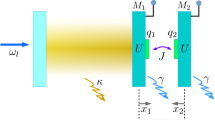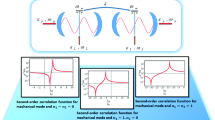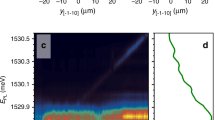Abstract
In a hybrid micromaser system consisting of an optical cavity with a moving mirror connected to a low-temperature thermal bath, we demonstrate, both analytically and numerically, that for certain interaction times between a random atomic flux and the optomechanical cavity, vacuum phonon trapping states are generated. Furthermore, under the approach of the master equation with independent phonon and photon thermal baths, we show that the trapping of the phonons and photons is achieved for the same interaction times. The results also indicate that by increasing the cavity-oscillator coupling, one may generate a coherent phonon state aside from the trapping states. Within the same hybrid system, but now connected to the squeezed phonon reservoir, a phonon blockade effect can be engineered. Moreover, we identify an interconnection between the trapping and blockade effects, particularly if one approaches the vacuum trapping state, strong phonon blockade can be achieved when the system is connected with a weakly squeezed phonon reservoir.






Similar content being viewed by others
Data Availibility Statement
No data associated in the manuscript.
References
S. Haroche, J.M. Raimond, Exploring the Quantum (Oxford Graduate Texts. Oxford Univerdity Press, Oxford, 2006)
E.T. Jaynes, F.W. Cummings, Comparison of quantum and semiclassical radiation theories with application to the beam maser. Proc. IEEE 51(1), 89–109 (1963). https://doi.org/10.1109/PROC.1963.1664
M.O. Scully, M.S. Zubairy, Quantum Optics (Cambridge University Press, Cambridge, 1997)
M. Orszag, Quantum Optics, 3rd edn. (Springer, Berlin, 2016)
R.H. Dicke, Coherence in spontaneous radiation processes. Phys. Rev. 93, 99–110 (1954). https://doi.org/10.1103/PhysRev.93.99
M. Gross, S. Haroche, Superradiance: an essay on the theory of collective spontaneous emission. Phys. Rep. 93(5), 301–396 (1982). https://doi.org/10.1016/0370-1573(82)90102-8
D.F. Walls, Nature 306, 5939 (1983). https://doi.org/10.1038/306141a0
P. Filipowicz, J. Javanainen, P. Meystre, Theory of a microscopic maser. Phys. Rev. A 34, 3077–3087 (1986). https://doi.org/10.1103/PhysRevA.34.3077
M. Weidinger, B.T.H. Varcoe, R. Heerlein, H. Walther, Trapping states in the micromaser. Phys. Rev. Lett. 82, 3795–3798 (1999). https://doi.org/10.1103/PhysRevLett.82.3795
S. Brattke, B.T.H. Varcoe, H. Walther, Generation of photon number states on demand via cavity quantum electrodynamics. Phys. Rev. Lett. 86, 3534–3537 (2001). https://doi.org/10.1103/PhysRevLett.86.3534
P. Meystre, M. Sargent, Elements of Quantum Optics, 4th edn. (Springer, Berlin, 2007)
N.A. Enaki, N. Ciobanu, Quantum trapping conditions for three-level atom flying through bimodal cavity field. J. Mod. Opt. 55(10), 1557–1569 (2008). https://doi.org/10.1080/09500340701721868
L. Davidovich, J.M. Raimond, M. Brune, S. Haroche, Quantum theory of a two-photon micromaser. Phys. Rev. A 36, 3771–3787 (1987). https://doi.org/10.1103/PhysRevA.36.3771
J. Bergou, L. Davidovich, M. Orszag, C. Benkert, M. Hillery, M.O. Scully, Role of pumping statistics in maser and laser dynamics: Density-matrix approach. Phys. Rev. A 40, 5073–5080 (1989). https://doi.org/10.1103/PhysRevA.40.5073
D. Meschede, H. Walther, G. Müller, One-atom maser. Phys. Rev. Lett. 54, 551–554 (1985). https://doi.org/10.1103/PhysRevLett.54.551
M. Brune, J.M. Raimond, P. Goy, L. Davidovich, S. Haroche, Realization of a two-photon maser oscillator. Phys. Rev. Lett. 59, 1899–1902 (1987). https://doi.org/10.1103/PhysRevLett.59.1899
H. Walther, Experiments on cavity quantum electrodynamics. Phys. Rep. 219(3), 263–281 (1992). https://doi.org/10.1016/0370-1573(92)90142-M
C.B. Dağ, W. Niedenzu, O.E. Müstecaplıoğlu, G. Kurizki, Multiatom quantum coherences in micromasers as fuel for thermal and nonthermal machines. Entropy 18 (2016). https://doi.org/10.3390/e18070244
P.D. Nation, Nonclassical mechanical states in an optomechanical micromaser analog. Phys. Rev. A 88, 053828 (2013). https://doi.org/10.1103/PhysRevA.88.053828
S. Dambach, A.D. Armour, B. Kubala, J. Ankerhold, Josephson junction cavity systems as cousins of the quantum optical micromaser. Phys. Scripta 94(10), 104001 (2019). https://doi.org/10.1088/1402-4896/ab2a90
A. Kouzelis, K. Macieszczak, J. Minář, I. Lesanovsky, Dissipative quantum state preparation and metastability in two-photon micromasers. Phys. Rev. A 101, 043847 (2020). https://doi.org/10.1103/PhysRevA.101.043847
C. Davis-Tilley, A.D. Armour, Synchronization of micromasers. Phys. Rev. A 94, 063819 (2016). https://doi.org/10.1103/PhysRevA.94.063819
M. Aspelmeyer, T.J. Kippenberg, F. Marquardt, Cavity optomechanics. Rev. Mod. Phys. 86, 1391–1452 (2014). https://doi.org/10.1103/RevModPhys.86.1391
C. Sánchez Muñoz, A. Lara, J. Puebla, F. Nori, Hybrid systems for the generation of nonclassical mechanical states via quadratic interactions. Phys. Rev. Lett. 121, 123604 (2018). https://doi.org/10.1103/PhysRevLett.121.123604
M. Mirhosseini, A. Sipahigil, M. Kalaee, O. Painter, Superconducting qubit to optical photon transduction. Nature 588, 599–603 (2020). https://doi.org/10.1038/s41586-020-3038-6
Y. Nakamura, Y.A. Pashkin, J.S. Tsai, Coherent control of macroscopic quantum states in a single-cooper-pair box. Nature 398, 786–788 (1999). https://doi.org/10.1038/19718
J.-Q. Liao, L. Tian, Macroscopic quantum superposition in cavity optomechanics. Phys. Rev. Lett. 116, 163602 (2016). https://doi.org/10.1103/PhysRevLett.116.163602
V. Montenegro, R. Coto, V. Eremeev, M. Orszag, Macroscopic nonclassical-state preparation via postselection. Phys. Rev. A 96, 053851 (2017). https://doi.org/10.1103/PhysRevA.96.053851
R.Y. Teh, S. Kiesewetter, P.D. Drummond, M.D. Reid, Creation, storage, and retrieval of an optomechanical cat state. Phys. Rev. A 98, 063814 (2018). https://doi.org/10.1103/PhysRevA.98.063814
M. Scala, M.S. Kim, G.W. Morley, P.F. Barker, S. Bose, Matter-wave interferometry of a levitated thermal nano-oscillator induced and probed by a spin. Phys. Rev. Lett. 111, 180403 (2013). https://doi.org/10.1103/PhysRevLett.111.180403
I. Marinkovi ć, A. Wallucks, R. Riedinger, S. Hong, M. Aspelmeyer, S. Gröblacher Optomechanical bell test. Phys. Rev. Lett. 121, 220404 (2018). https://doi.org/10.1103/PhysRevLett.121.220404
Y.-X. Liu, A. Miranowicz, Y.B. Gao, J. Bajer, C.P. Sun, F. Nori, Qubit-induced phonon blockade as a signature of quantum behavior in nanomechanical resonators. Phys. Rev. A 82, 032101 (2010). https://doi.org/10.1103/PhysRevA.82.032101
N. Didier, S. Pugnetti, Y.M. Blanter, R. Fazio, Detecting phonon blockade with photons. Phys. Rev. B 84, 054503 (2011). https://doi.org/10.1103/PhysRevB.84.054503
X. Wang, A. Miranowicz, H.-R. Li, F. Nori, Method for observing robust and tunable phonon blockade in a nanomechanical resonator coupled to a charge qubit. Phys. Rev. A 93, 063861 (2016). https://doi.org/10.1103/PhysRevA.93.063861
J. Restrepo, I. Favero, C. Ciuti, Fully coupled hybrid cavity optomechanics: Quantum interferences and correlations. Phys. Rev. A 95, 023832 (2017). https://doi.org/10.1103/PhysRevA.95.023832
X.-W. Xu, H.-Q. Shi, J.-Q. Liao, A.-X. Chen, Generation of single entangled photon-phonon pairs via an atom-photon-phonon interaction. Phys. Rev. A 100, 053802 (2019). https://doi.org/10.1103/PhysRevA.100.053802
S. Debnath, N.M. Linke, S.-T. Wang, C. Figgatt, K.A. Landsman, L.-M. Duan, C. Monroe, Observation of hopping and blockade of bosons in a trapped ion spin chain. Phys. Rev. Lett. 120, 073001 (2018). https://doi.org/10.1103/PhysRevLett.120.073001
H.Q. Shi, X.W. Xu, N.H. Liu, Phonon blockade in a nanomechanical resonator quadratically coupled to a two-level. Sci. Rep. 9 (2019). https://doi.org/10.1038/s41598-019-45027-z
L.-L. Zheng, T.-S. Yin, Q. Bin, X.-Y. Lü, Y. Wu, Single-photon-induced phonon blockade in a hybrid spin-optomechanical system. Phys. Rev. A 99, 013804 (2019). https://doi.org/10.1103/PhysRevA.99.013804
J.-Y. Yang, Z. Jin, J.-S. Liu, H.-F. Wang, A.-D. Zhu, Unconventional phonon blockade in a tavis–cummings coupled optomechanical system. Annalen der Physik 532(12), 2000299 (2020). https://doi.org/10.1002/andp.202000299
H. Lin, H. Yang, X. Wang, Y. Zhou, Z. Yao, Realization of the unconventional photon blockade based on a three-wave mixing system. Opt. Exp. 29(6), 8235–8243 (2021). https://doi.org/10.1364/OE.416285
Y.-X. Zeng, T. Gebremariam, J. Shen, B. Xiong, C. Li, Application of machine learning for predicting strong phonon blockade. Appl. Phys. Lett. 118(16), 164003 (2021). https://doi.org/10.1063/5.0035498
A. Imamoḡ lu, H. Schmidt, G. Woods, M. Deutsch, Strongly interacting photons in a nonlinear cavity. Phys. Rev. Lett. 79, 1467–1470 (1997). https://doi.org/10.1103/PhysRevLett.79.1467
X. Wang, W. Qin, A. Miranowicz, S. Savasta, F. Nori, Unconventional cavity optomechanics: Nonlinear control of phonons in the acoustic quantum vacuum. Phys. Rev. A 100, 063827 (2019). https://doi.org/10.1103/PhysRevA.100.063827
K.M. Birnbaum, A. Boca, R. Miller, A.D. Boozer, T.E. Northup, H.J. Kimble, Photon blockade in an optical cavity with one trapped atom. Nature 436, 87–90 (2005). https://doi.org/10.1038/nature03804
C. Hamsen, K.N. Tolazzi, T. Wilk, G. Rempe, Two-photon blockade in an atom-driven cavity qed system. Phys. Rev. Lett. 118, 133604 (2017). https://doi.org/10.1103/PhysRevLett.118.133604
H.J. Snijders, J.A. Frey, J. Norman, H. Flayac, V. Savona, A.C. Gossard, J.E. Bowers, M.P. van Exter, D. Bouwmeester, W. Löffler, Observation of the unconventional photon blockade. Phys. Rev. Lett. 121, 043601 (2018). https://doi.org/10.1103/PhysRevLett.121.043601
C. Vaneph, A. Morvan, G. Aiello, M. Féchant, M. Aprili, J. Gabelli, J. Estève, Observation of the unconventional photon blockade in the microwave domain. Phys. Rev. Lett. 121, 043602 (2018). https://doi.org/10.1103/PhysRevLett.121.043602
A. Majumdar, M. Bajcsy, A. Rundquist, J. Vučkovi ć Loss-enabled sub-poissonian light generation in a bimodal nanocavity. Phys. Rev. Lett. 108, 183601 (2012). https://doi.org/10.1103/PhysRevLett.108.183601
P. Rabl, Photon blockade effect in optomechanical systems. Phys. Rev. Lett. 107, 063601 (2011). https://doi.org/10.1103/PhysRevLett.107.063601
A. Miranowicz, J. Bajer, N. Lambert, Y.-X. Liu, F. Nori, Tunable multiphonon blockade in coupled nanomechanical resonators. Phys. Rev. A 93, 013808 (2016). https://doi.org/10.1103/PhysRevA.93.013808
S.S. Shamailov, A.S. Parkins, M.J. Collett, H.J. Carmichael, Multi-photon blockade and dressing of the dressed states. Opt. Commun. 283(5), 766–772 (2010). https://doi.org/10.1016/j.optcom.2009.10.062. Quo vadis Quantum Optics?
A. Miranowicz, M. Paprzycka, Y.-X. Liu, J. Bajer, F. Nori, Two-photon and three-photon blockades in driven nonlinear systems. Phys. Rev. A 87, 023809 (2013). https://doi.org/10.1103/PhysRevA.87.023809
R. Huang, A. Miranowicz, J.-Q. Liao, F. Nori, H. Jing, Nonreciprocal photon blockade. Phys. Rev. Lett. 121, 153601 (2018). https://doi.org/10.1103/PhysRevLett.121.153601
B. Li, R. Huang, X. Xu, A. Miranowicz, H. Jing, Nonreciprocal unconventional photon blockade in a spinning optomechanical system. Photon. Res. 7(6), 630–641 (2019). https://doi.org/10.1364/PRJ.7.000630
P. Yang, M. Li, X. Han, H. He, G. Li, C.-L. Zou, P. Zhang, T. Zhang, Non-reciprocal cavity polariton. arXiv (2019). https://doi.org/10.48550/ARXIV.1911.10300. https://arxiv.org/abs/1911.10300
T.C.H. Liew, V. Savona, Single photons from coupled quantum modes. Phys. Rev. Lett. 104, 183601 (2010). https://doi.org/10.1103/PhysRevLett.104.183601
A. Miranowicz, J. Bajer, M. Paprzycka, Y.-X. Liu, A.M. Zagoskin, F. Nori, State-dependent photon blockade via quantum-reservoir engineering. Phys. Rev. A 90, 033831 (2014). https://doi.org/10.1103/PhysRevA.90.033831
A. Kowalewska-Kudłaszyk, S.I. Abo, G. Chimczak, J. Pe řina, F. Nori, A. Miranowicz, Two-photon blockade and photon-induced tunneling generated by squeezing. Phys. Rev. A 100, 053857 (2019). https://doi.org/10.1103/PhysRevA.100.053857
K.W. Murch, K.L. Moore, S. Gupta, D.M. Stamper-Kurn, Observation of quantum-measurement backaction with an ultracold atomic gas. Nature 4 (2008). https://doi.org/10.1038/nphys965
J. Chan, T.P.M. Alegre, A.H. Safavi-Naeini, J.T. Hill, A. Krause, S. Gröblacher, M. Aspelmeyer, O. Painter, Laser cooling of a nanomechanical oscillator into its quantum ground state. Nature 478 (2011). https://doi.org/10.1038/nature10461
A. Xuereb, C. Genes, A. Dantan, Strong coupling and long-range collective interactions in optomechanical arrays. Phys. Rev. Lett. 109, 223601 (2012). https://doi.org/10.1103/PhysRevLett.109.223601
H. Molinares, V. Eremeev, M. Orszag, High-fidelity synchronization and transfer of quantum states in optomechanical hybrid systems. Phys. Rev. A 105, 033708 (2022). https://doi.org/10.1103/PhysRevA.105.033708
H.J. Carmichael, Statistical Methods in Quantum Optics 1, 1st edn. (Springer, Berlin, 1999)
N. Petrov, V. Pustovoit, Small-sized interferometer with fabry-perot resonators for gravitational wave detection. Sensors 21(5) (2021). https://doi.org/10.3390/s21051877
M. Orszag, R. Ramírez, J.C. Retamal, C. Saavedra, Quantum cooperative effects in a micromaser. Phys. Rev. A 49, 2933–2937 (1994). https://doi.org/10.1103/PhysRevA.49.2933
Acknowledgements
H.M. acknowledge financial support from Universidad Mayor through the Doctoral fellowship. M.O. acknowledge the financial support from ANID Fondecyt Regular No. 1180175. V.E. acknowledge the financial support from ANID Fondecyt Regular No. 1221250 and grant No. 20.80009.5007.01 of the State Program (2020–2023) from National Agency for Research and Development of Moldova.
Author information
Authors and Affiliations
Corresponding authors
Ethics declarations
Conflict of interest
The authors declare no competing interests.
Appendices
Appendix A: Hamiltonian in the interaction picture
This appendix provides the derivation of the initial Hamiltonian Eq. 1 in the interaction picture. Let us introduce the operator counting the number of atom-cavity polaritonic excitations:
We observe that this polariton number operator commutes with the Hamiltonian of the system, \([\hat{\mathcal {H}},\hat{\mathcal {N}}]=0\). Therefore, the Hamiltonian of the closed system is block-diagonal in the basis of eigenvectors of the polariton number operator. By considering the detuning \(\delta =\omega _{a}-\omega _{c}\), the Hamiltonian in Eq. 1 can be written as
where
Now, we calculate the Hamiltonian in the first interaction picture, that is
Using the fact that
for any function f, unitary operator \(\mathcal {{\hat{U}}}\) and arbitrary set of operators \(\left\{ \mathcal {{\hat{X}}}_{i}\right\}\), so Eq. A4 takes the form
where
Now, we move to a second interaction picture, defined as
The result of the transformation is easily calculated to be finally Eq. 2
Appendix B: Phonon gain superoperator
This section presents the derivation of the gain part of the maser ME for the MO operator. We consider an initial atom-cavity-oscillator operator as
where the atom was taken in the ground state. After the interaction time \(\tau\), the total density operator evolves according to Eq. 3. After a straightforward calculation, one gets
where \(\mathcal {{\hat{D}}}^{\dag }\) is hermitian conjugate of \(\mathcal {{\hat{D}}}\), see Eq. 5.
Next, tracing over the atom, the cavity-MO reduced operator reads
In the following, we consider the cavity field initialized in a coherent state (Eq. 8). Hence, the above equation becomes
where
Finally tracing over the cavity, we find Eqs. 10, 11 and 12.
Appendix C: Solution of the Fokker-Planck equation
Here, we present the steps to get the solution 16 of the Fokker-Planck equation 15. Let us consider the MO initially is in a coherent state, i.e., in the Gaussian representation takes the form
By considering a solution type \(P(\beta ,\beta ^{*},t)=\exp {\left[ a(t)+b(t)\beta +c(t)\beta ^{*}+d(t)\beta \beta ^{*}\right] }\), one obtains a set of first-order differential equations
For an initial thermal distribution, \(\epsilon ={\bar{n}}_{th}\), \(\beta _{0}=0\) and after a straightforward calculation, we get
with \(\beta _{1}=2\lambda r B(\tau )\kappa _{b}^{-1}(1-\exp {\left[ -\kappa _{b}t/2\right] })\). Finally, the last equation can be written compactly as Eq. 16.
Appendix D: Phonon trapping condition
The critical values of the pump parameter, \(\Theta\), where the phonon trapping vacuum states occur, are calculated from the condition of the minimum value for the steady-state average phonon number: \(\frac{\partial }{\partial \Theta }\langle {\hat{b}}^{\dag }{\hat{b}}\rangle =0\) with \(\frac{\partial ^{2}}{\partial \Theta ^{2}}\langle {\hat{b}}^{\dag }{\hat{b}}\rangle >0\). So the derivative of Eq. 18 gives
Taking into account that \(\left\{ \alpha ,g_{ac},r,\lambda ,\kappa _{b}\right\} >0\), the phonon trapping state is valid for
Finally, the above equation can be solved numerically, and the minimal values for \(\langle {\hat{b}}^{\dag }{\hat{b}}\rangle\) are found, see vertical lines in Fig. 2b.
Appendix E: Calculation of \(g_{b}^{(2)}(0)\)
To calculate the second-order correlation function for phonons, \(g_{b}^{(2)}(0)=\langle {\hat{b}}^{\dag }{\hat{b}}^{\dag }{\hat{b}}{\hat{b}}\rangle /\langle {\hat{b}}^{\dag }b\rangle ^{2}\), we consider convenient to use the moment-generating function
where \(P(n)=\int d^{2}\beta P(\beta ,\beta ^{*},t)\vert \langle n\vert \beta \rangle \vert ^{2}\) is the probability to have n phonons in the MO and \(P(\beta ,\beta ^{*},t)\) is defined in Eq. 16. After a straightforward calculation, one obtains
Finally, using the definition \(g^{(2)}(0)=\frac{1}{\langle n\rangle }\frac{d^{2}\mathcal {Q}}{ds^{2}}\vert _{s=0}\), see [3], we get Eq. 23.
Rights and permissions
Springer Nature or its licensor holds exclusive rights to this article under a publishing agreement with the author(s) or other rightsholder(s); author self-archiving of the accepted manuscript version of this article is solely governed by the terms of such publishing agreement and applicable law.
About this article
Cite this article
Molinares, H., Eremeev, V. & Orszag, M. Phonon trapping states as a witness for generation of phonon blockade in a hybrid micromaser system. Eur. Phys. J. Plus 137, 981 (2022). https://doi.org/10.1140/epjp/s13360-022-03148-x
Received:
Accepted:
Published:
DOI: https://doi.org/10.1140/epjp/s13360-022-03148-x




